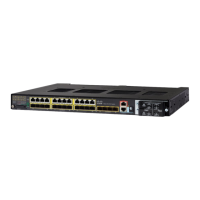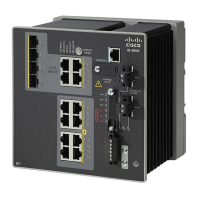Removing and installing an SFP module can shorten its useful life. Do not remove and insert any module
more often than is absolutely necessary.
Note
Installing Fiber Optic SFP Modules
Class 1 laser product. Statement 1008
Warning
To install and cable an optical SFP transceiver uplink port:
1. Attach an ESD-preventive wrist strap to your wrist and to a bare metal surface.
2. Find the send (TX) and receive (RX) markings on the module top.
On some SFP modules, the send and receive (TX and RX) markings might be replaced by arrows that
show the direction of the connection, either send or receive (TX or RX).
3. If the module has a bale-clasp latch, move it to the open, unlocked position.
4. Align the module in front of the slot opening, and push until you feel the connector snap into place.
5. If the module has a bale-clasp latch, close it.
6. For fiber-optic SFP modules, remove the dust plugs and save.
7. Connect the SFP cables.
Figure 16: Installing an SFP Module
Do not remove the dust plugs from the fiber-optic SFP module port or the rubber caps from the fiber-optic
cable until you are ready to connect the cable. The plugs and caps protect the SFP module ports and cables
from contamination and ambient light.
Caution
Cisco IE 4010 Switch Hardware Installation Guide
29
Switch Installation
Installing Fiber Optic SFP Modules

